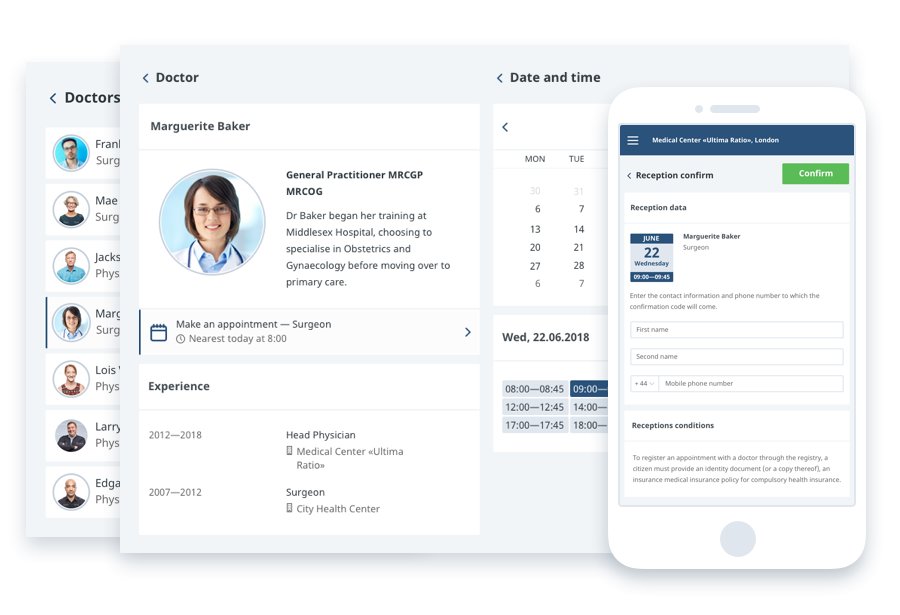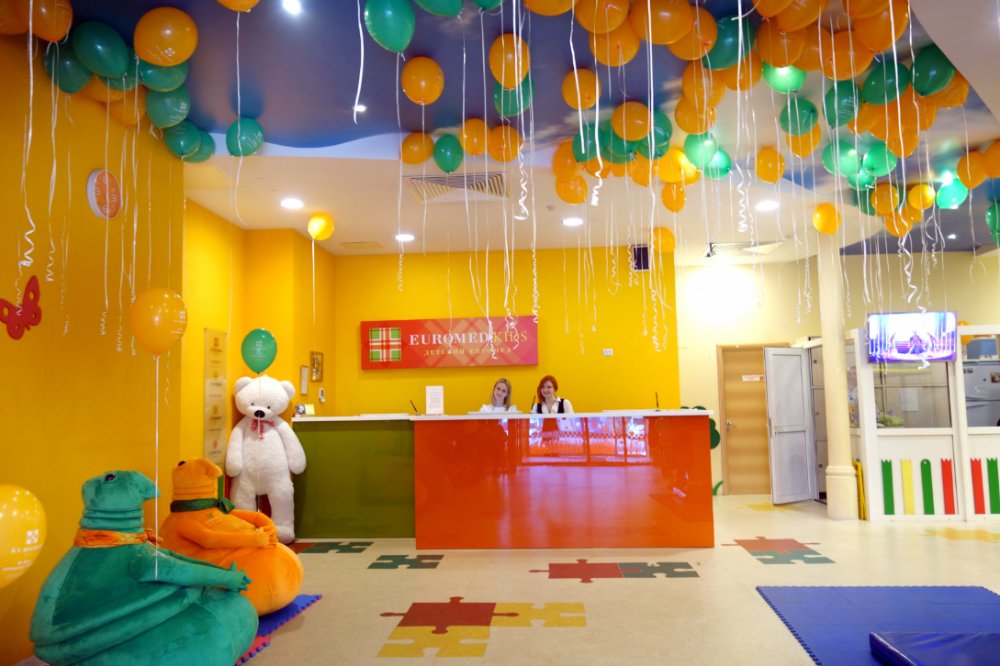Your new project is an interesting one and you’ve already implemented your service design model in a wide range of clinics. First of all, what is service design and how does it work?
You will come across examples of service design in a range of totally different industry sectors, including healthcare. Ultimately, it’s all about turning the so-called user experience into a full-on project. That is to say, focusing on your clients’ experience at every point at which they might encounter your brand.
Learn how to simplify your practice workflow and free up more time for patients with Medesk.
Open the detailed description >>Service design considers more than just obvious direct ways of communicating with consumers. It starts at street level and shows you that potential clients are walking straight past your clinic because it’s difficult to find you and there’s no easy way of learning which services you provide without coming inside the clinic premises. This is a simple point of contact that you’ve either worked on or you’ve missed out on.
We strive to make our services and the path to actually visiting our clinic as straightforward as possible. For a start, our websites are user-friendly, making the patient journey from cyberspace to the clinic happen with the absolute minimum of clicks and additional options to book 24/7 via a patient portal. Everything is clear and transparent for our clients.
Having an online booking solution with convenient time slots is not anything difficult to implement for all clinics. As a mother with a small baby, I find it incredibly simple to book an appointment with our paediatrician even when I’ve just been woken up in the middle of the night. Being able to pay a deposit for the appointment online without having to wait to make a payment over the phone with a receptionist during the day is an extra bonus for me. I never have to worry about not getting an appointment.

When it comes to the patient experience, seemingly small things matter more than you might think. For example, the association between the sense of smell and memory is a strong one, meaning that the stereotypical smell of clinical environments is enough to bring up plenty of unpleasant memories. After all, most patients have a certain degree of apprehension before they have come anywhere close to your clinic on the day of their appointment, and the last thing they need is to be reminded of unsavoury past experiences from elsewhere. Our job is to reduce patients’ stress levels, whether adult or child, so we ought to be aiming to make our clinic reception and corridors give the same impression as would a hotel. And, when it comes to kids, don’t forget about the play area!
Medesk helps automate scheduling and record-keeping, allowing you to recreate an individual approach to each patient, providing them with maximum attention.
Learn more >>It’s important to realise that service design considers the workplace as a whole and not just as a series of connected but ultimately separate service areas. In particular, if your patients are made to feel uncomfortable at any point by the time they have left the consulting room, they may not return for a repeat visit. This is often the case when the consultant has failed to assuage the patient’s fears or did not answer all the questions put forward.
 Photo: Euromed Kids
Photo: Euromed Kids
Let’s say a clinic wants to implement service design in its premises. Where do you start? What tools can help you with this?
For a start, it’s worth observing what is currently going on before conducting situational interviews. We started with questions like: “What else can we do here?” It was about addressing what we could do better or differently from other clinics. We tried to put ourselves in the shoes of our clients as only once you see their side of the story can you truly notice what you simply can’t see from the other side of the desk.
It’s often basic omissions like the lack of a place to put bags and coats or unnecessary additions like a large desk acting as a physical and psychological barrier between patients and receptionists. Service design is all about looking at these points of contact and making sure you have addressed and exceeded the patients’ expectations by predicting their typical patterns of behaviour. Such details may not seem obvious until you step out and look at your clinic from a patient’s perspective. If you can take action on even these seemingly small issues, you will have already placed yourself head and shoulders above the rest.
We are constantly finding simple things that we didn’t notice before, and to fix them takes very little money or time, but it does make patients much more comfortable right away.
How can you understand that your service design is working effectively?
In a certain sense, service design is quite hard to evaluate. I mean, how do you even measure loyalty? In any case, we make working hypotheses that we must test, so we have to have some defined criteria by which we measure the effectiveness of aspects of service design.
We want to increase the number of repeat visits or loyal patients up to a specific number over a given time period. In the course of our work with hypotheses, we look at why patients trust us, why they are ready to pay or not pay for a service, why they have stopped booking and so on. Is it a problem with the service itself or that there’s a new doctor providing it? Perhaps this new hire isn’t getting across our values and our sense of duty of care, meaning that the patient doesn’t want to pay for our services any longer.
It often happens in business that you’ve developed a particular idea, spend time and resources on it, and the client comes back to you and says: “You know, this isn’t something that’s really important to me anymore”. Service design combats this as it is ultimately a minimalistic and gradual approach. In other words, you make a simple change that doesn’t take 6 months to push through and you test it right away. You gather a focus group or arrange interviews with individuals and ask: “Is this meaningful to you? If not, why not?” When patients respond positively, we then look at whether they would be willing to actually pay for the service in its current form or do we need to add to it in some way.
It’s kind of like interval training in that you’re actually running a marathon while making plenty of stops to check the time, the route and even the state of your footwear. Most important of all, you’re stopping to remind yourself what you’re doing and for whom you’re doing it.
I would like to share a concrete example of a hypothesis that we had in one of our women’s health clinics where, obviously, all our clients are women. Our marketing campaigns were targeting a female audience as you would expect, but when we were developing some service design hypotheses, we realised that actually the vast majority of our clients ultimately consisted of couples who wanted to become parents. As such, the decision-making process was not controlled solely by the women who were our patients. In fact, it was a joint decision and in 30% of cases, it was the male partner who was more involved in the decision to purchase our services. In one interview, we were literally told: “When we decided to undergo IVF, my husband said that we absolutely must do it only with your clinic”. This enabled us to re-examine the direction of our marketing campaigns as a whole as well as for individual products. In particular, we realised that we had to start including men in our interviews for the next stage of our service design process.
Discover more about the essential features of Medesk and claim your free access today!
Explore now >>Staying on the topic of men, we recently noticed that almost a quarter of reviews and testimonials about paediatric clinics are left by fathers, who write to tell us what we’re doing well and what we need to change. What I really wanted to point out, though, is that they spend their own time to give this feedback and it goes to show that today’s target audience is not the same as yesterday’s by any means. The same goes for the various points of service design too. That is, if we stopped speaking to our patients right now, we would quickly become obsolete in what we offer and how we offer it.
Once the door to the doctor’s office closes, the patient comes to learn about the clinic’s values and standards from that doctor. Nothing you do after the patient has left this room will alter that first impression.
Do your clinic’s doctors support your projects? What has changed about the way they work with patients?
The main drivers of change in the form of service design and the clinic’s overall mission are members of the admin and marketing teams. In terms of the internal promotion of these ideas to the medical team, you could see it’s a therapeutic process in itself. Pushing new standards of care comes first and some clinicians do find it harder to adapt than others. I don’t think this is something unique to our company but rather applies to just about any healthcare organisation.
Once the door to the doctor’s office closes, the patient comes to learn about the clinic’s values and standards from that doctor. Nothing you do after the patient has left this room will alter that first impression, that initial point of contact. In the provision of a particular service, a doctor must act in sync with reception staff and all their other colleagues in the clinic. Simply being an adequate specialist in your field is no longer anywhere near enough in the private sector. Effective communication is vital here.
Service design is about looking at how you can develop and remain one step ahead. While we must take care to act according to unified standards as checked by the CQC and other bodies, what can we do to stand out today? We consider this question particularly in relation to our quickly getting used to new technology for the betterment of the patient experience.

